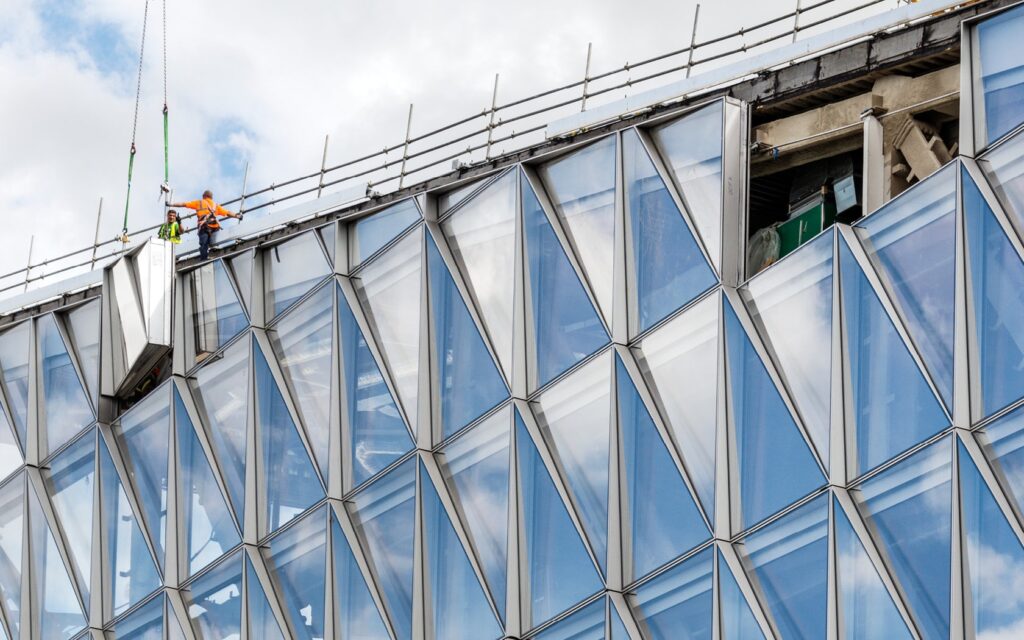
A semi-unitized aluminium section for glass facades is a system in which the vertical and horizontal structural mullions are preassembled in a factory into a single unit, which is then installed on-site. The glazing panels are installed into the preassembled mullion unit, typically with the use of pressure plates and gaskets.
Unitized aluminium sections are widely used in the construction industry for building facades, particularly in high-rise buildings. The system consists of pre-assembled panels that are manufactured offsite and then transported to the construction site for installation.
Uses of Unitised Aluminium Section
- Building Facades: The unitized aluminium section is a popular choice for building facades, particularly in high-rise buildings, due to its lightweight, durability, and versatility. The system allows for rapid installation, reducing construction time and costs.
- Curtain Walls: Curtain walls are an exterior cladding system that uses unitized aluminium sections to support the glass panels. The system is popular in commercial buildings as it allows natural light to enter the building while maintaining thermal insulation and energy efficiency.
- Skylights: Unitized aluminium sections are also used in the construction of skylights, which are roof windows that allow natural light to enter the building. The system provides structural support to the glass panels and allows for the installation of large glazed areas.
- Louvers: Louvers are a type of ventilation system that uses unitized aluminium sections to create a louvered facade. The system allows for the regulation of airflow, temperature, and sunlight, making it a popular choice in buildings that require natural ventilation.
Overall, the unitized aluminium section is a versatile and durable solution for building facades, curtain walls, skylights, and louvers. Its lightweight and energy-efficient properties make it a popular choice in modern construction projects.
Advantages of Unitised Aluminium Section
- Faster Installation: Unitized aluminium sections are prefabricated offsite, allowing for quicker installation on-site. This reduces labor costs and construction time, making it an attractive option for larger commercial buildings.
- Improved Quality: The prefabrication process allows for higher quality control, resulting in fewer on-site errors during installation. This leads to a better quality finished product and reduces the need for rework.
- Energy Efficiency: The use of unitized aluminium sections can improve energy efficiency in buildings. The system can be designed to incorporate thermal breaks, which reduce energy transfer and improve thermal performance.
- Design Flexibility: Unitized aluminium sections can be designed to meet specific design requirements, allowing architects and designers greater flexibility in creating building facades and curtain walls. This includes a variety of colors, finishes, and shapes.
- Durability: Aluminium is a durable and corrosion-resistant material that can withstand harsh weather conditions. Unitized aluminium sections are designed to provide structural support and maintain their strength over time.
- Reduced Maintenance: The use of unitized aluminium sections can reduce maintenance costs over time as they require less maintenance than traditional stick-built systems.
- Improved Safety: Unitized aluminium sections can be designed to incorporate safety features, such as fire resistance and impact resistance, providing a safer environment for building occupants.
Conclusion
In conclusion, unitized aluminium sections offer a range of benefits for construction and engineering projects, including ease of assembly, cost-effectiveness, and durability. They are designed to interlock with each other, creating a pre-fabricated unit or system that can be easily transported and installed on site. Additionally, aluminium is a lightweight and corrosion-resistant material that makes it ideal for use in various applications. Overall, unitized aluminium sections are a versatile solution for creating efficient, high-quality structures and systems.
